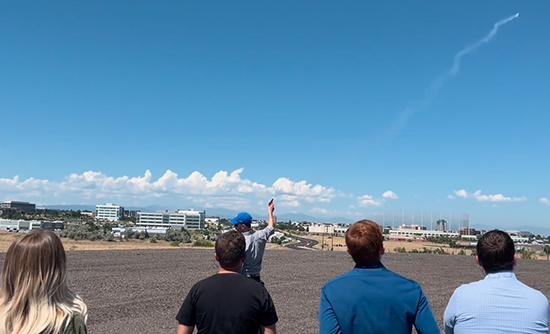Photo above – Wildlife Biologist Jonathan Matthews demonstrates the use of pyrotechnics to mitigate airport wildlife hazards to airport staff during a training session at Centennial Airport (APA) on August 11, 2022.
The United States Department of Agriculture (USDA) has been hard at work this year educating the managers and sponsors at many of Colorado’s public-use airports about the mitigation of wildlife hazards at their airports. This training helps airports to reduce wildlife aircraft strikes and damage to airport infrastructure.
The Colorado Division of Aeronautics has partnered with the USDA to help give airport management and staff the knowledge and skills to understand and proactively address wildlife hazards at their airports. This training is conducted by a qualified USDA Airport Wildlife Biologist and is partially funded by the Colorado Aviation Fund administered by the Colorado Division of Aeronautics.
The Federal Aviation Administration (FAA) currently requires airports with commercial airline service to receive annual wildlife hazard management training for all airport operations staff. This training is also made available upon request to other Colorado general aviation airports.
To date, the USDA has conducted training for nearly 130 airport staff members at 12 airports around Colorado. These airports include Montrose Regional Airport (MTJ), Alamosa-San Luis Valley Regional Airport (ALS), Cortez-Montezuma County Airport (CEZ), Durango-La Plata County Airport (DRO), Northern Colorado Regional Airport (FNL), Telluride Regional Airport (TEX), Gunnison-Crested Butte Regional Airport (GUC), Eagle County Regional Airport (EGE), Hayden-Yampa Valley Regional Airport (HDN), Grand Junction Regional Airport (GJT), Rocky Mountain Regional Airport (BJC), and Centennial Airport (APA).
The Wildlife Hazard Management training given by Wildlife Services (WS) in Colorado adheres to the FAA curriculum which trains airport operation staff to recognize wildlife hazards on their airfield and how to choose the best solution to solve or mitigate these hazards. The training also focuses on how to identify and report wildlife strikes, relevant wildlife laws and regulations, wildlife identification tailored to each airport or region of Colorado, and hands-on demonstrations of non-lethal wildlife dispersal techniques such as pyrotechnics.
One of the key points of the training is to learn about the natural behavior of certain species of wildlife found at airports around Colorado. “Wildlife can be an unpredictable variable in the airport safety equation; therefore, making sure airports keep their “toolboxes” prepared is vital to their ability to respond to wildlife hazards”, said USDA Wildlife Biologist Jonathan Matthews.
USDA Wildlife Services provides science-based leadership and expertise to reduce conflicts between wildlife and humans in the airport environment, enhancing the overall safety at Colorado’s public-use airports. To learn more about this program, please visit the USDA Airport Wildlife Hazards Program website.



